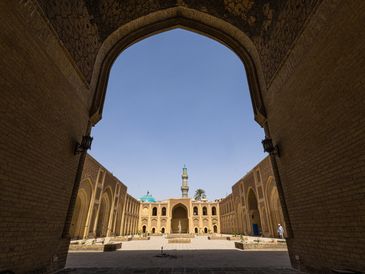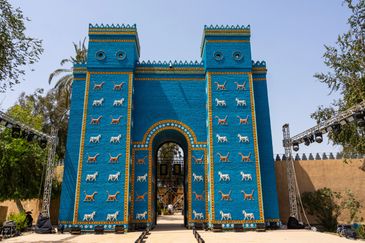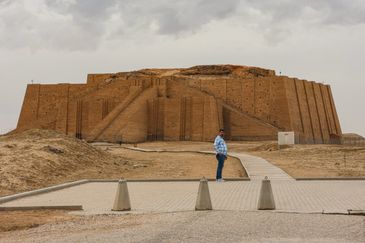Iraq destinations

Baghdad Downtown
It is located on the eastern side of the Tigris River and is considered the heart of the city. It includes the famous Baghdad Market. Starting with Souk al-Safafeer which is an ancient souk or bazaar that branches off al-Rashid Street and connects to "Mustansiriyah Madrasah", which dates back to 1233 AD. The souk was established in the A
It is located on the eastern side of the Tigris River and is considered the heart of the city. It includes the famous Baghdad Market. Starting with Souk al-Safafeer which is an ancient souk or bazaar that branches off al-Rashid Street and connects to "Mustansiriyah Madrasah", which dates back to 1233 AD. The souk was established in the Abbasid period and has been active ever since.
The old town also contains the famous "Al-Mutanabbi Street," a street known for its bookstores and cafes. At the end of Baghdad Downtown there is located Abbasid Palace, which is an ancient Abbasid complex from 1181 AD”.

Babylon
The archaeological site of Babylon is located 85 km south of Baghdad. It consists of the ruins of the city that was, between 626 and 539 BC, the center of the Neo-Babylonian Empire, along with several villages and agricultural areas surrounding the old city. These monuments - inner and outer city
walls, gates, palaces, and temples - offer
The archaeological site of Babylon is located 85 km south of Baghdad. It consists of the ruins of the city that was, between 626 and 539 BC, the center of the Neo-Babylonian Empire, along with several villages and agricultural areas surrounding the old city. These monuments - inner and outer city
walls, gates, palaces, and temples - offer a unique testimony to one of the most
influential empires in the ancient world.
Babylon was the seat of several
successive empires, led by rulers such as Hammurabi or King Nebuchadnezzar.
Babylon embodies the creativity of the neo- Neo-Babylonian Empire at its height. The city's association with one of the Seven Wonders of the Ancient World - the Hanging Gardens of Babylon - had an impact on forms of artistic, popular, and religious culture worldwide.

The marshes
It is also known locally as the Chibayish Marshes، it is a group of water bodies that cover the lowlands located in the south of the Iraqi alluvial plain, and they are in the form of a
triangle, the cities of Nasiriyah and Basra are located on its heads.
The marshlands used to be the largest wetland ecosystem in Western Eurasia, representin
It is also known locally as the Chibayish Marshes، it is a group of water bodies that cover the lowlands located in the south of the Iraqi alluvial plain, and they are in the form of a
triangle, the cities of Nasiriyah and Basra are located on its heads.
The marshlands used to be the largest wetland ecosystem in Western Eurasia, representing a rare aquatic landscape in the desert and providing a habitat for important populations of wildlife.
There you'll see the traditional reed houses and the Madheef which is the guest house where members of the tribes gather to socialize and settle disputes. There you can ride a boat through the reeds and the buffalos and meet the marsh arabs.

Ziggurat of Ur
The ziggurat is the most distinctive
the architectural invention of the Ancient Near East. Like an ancient Egyptian pyramid, an ancient Near Eastern ziggurat has four sides and rises to the realm of the gods. However, unlike Egyptian pyramids, the exterior of Ziggurats was not smooth but tiered to accommodate the work which took
place at th
The ziggurat is the most distinctive
the architectural invention of the Ancient Near East. Like an ancient Egyptian pyramid, an ancient Near Eastern ziggurat has four sides and rises to the realm of the gods. However, unlike Egyptian pyramids, the exterior of Ziggurats was not smooth but tiered to accommodate the work which took
place at the structure as well as the
administrative oversight and religious rituals essential to Ancient Near Eastern cities.
A UNESCO world heritage site since 2016 and the former capital of Mesopotamia during the Sumerian time and the place where Ibraham was likely born. Ur was a major Sumerian urban center on the Mesopotamian plain. In the 21st century BC King Ur-Nammu united the cities of Sumer under his rule and formed a strong wealthy dynasty that made Ur the political and economic power of Mesopotamia. The site includes the Great Ziggurat of Ur, Abraham House, Sholgi Palace, and the oldest arch of its kind at the entrance of the Dub-Lal-Makh Temple.

Uruk
Uruk was one of the most important cities (at one time, the most important) in ancient Mesopotamia. According to the Sumerian King List, it was founded by King Enmerkar c. 4500 BCE. Uruk is best known as the birthplace of writing c. 3200 BCE as well as for its architecture and other cultural innovations.
It is considered the first true cit
Uruk was one of the most important cities (at one time, the most important) in ancient Mesopotamia. According to the Sumerian King List, it was founded by King Enmerkar c. 4500 BCE. Uruk is best known as the birthplace of writing c. 3200 BCE as well as for its architecture and other cultural innovations.
It is considered the first true city in the world, the origin of writing, the first example of architectural work in stone and the building of great stone structures, the origin of the ziggurat and the first city to develop the cylinder seal which the ancient Mesopotamians used to designate personal property or as a signature on documents.

Karbala
The holy city of Karbala is 100 km away from Baghdad and it holds
the shrine of Imam Hussein which is a mosque and a burial site of
the third Imam of Shia Islam and his brother.
The Tomb is considered the holiest site after Mecca and Millions of
muslims make pilgrimages to Karbala every year in the time that
marks the commemoration of Hussein'
The holy city of Karbala is 100 km away from Baghdad and it holds
the shrine of Imam Hussein which is a mosque and a burial site of
the third Imam of Shia Islam and his brother.
The Tomb is considered the holiest site after Mecca and Millions of
muslims make pilgrimages to Karbala every year in the time that
marks the commemoration of Hussein's death.
The site is always busy with people from all over the world, the
shine itself has golden domes and gates that have its unique design
and a roof with millions of glass decorations that gives the visitor a
unique spiritual experience.

Najaf
Samarra
Najaf is one of the most important cities in Iraq, known for its deep religious and historical significance. It is home to the sacred shrine of Imam Ali, the cousin and son-in-law of the Prophet Muhammad, which attracts millions of pilgrims every year. The city also contains Wadi al-Salam Cemetery, the largest cemetery in the world, where
Najaf is one of the most important cities in Iraq, known for its deep religious and historical significance. It is home to the sacred shrine of Imam Ali, the cousin and son-in-law of the Prophet Muhammad, which attracts millions of pilgrims every year. The city also contains Wadi al-Salam Cemetery, the largest cemetery in the world, where millions of people have been buried for centuries. Najaf is considered a center of Islamic learning and spirituality, with many seminaries and scholars. Its unique atmosphere combines faith, history, and culture in one remarkable place.

Samarra
Samarra
The archaeological city of Samarra in Iraq offers a close look at life under the Abbasid caliphate, the major Islamic empire which ruled large swathes of North Africa, the Middle East, and Central Asia between the 8th and 13th centuries. The Great Mosque of Samarra, built-in 851, was the world's largest mosque at the time of construction.
The archaeological city of Samarra in Iraq offers a close look at life under the Abbasid caliphate, the major Islamic empire which ruled large swathes of North Africa, the Middle East, and Central Asia between the 8th and 13th centuries. The Great Mosque of Samarra, built-in 851, was the world's largest mosque at the time of construction. Its unusual and iconic spiral minaret remains mostly intact, standing at 52 meters tall.

Arch of Ctesiphon
One of the ancient architectural masterpieces. Built during the long wars between the Byzantine Empire and Persian Empire and served as the last capital of the Persians before the Muslim's conquest of Persia.

Hatra kingdom
Hatra was founded in the 3rd or 2nd century BCE, under the Seleucid kingdom, It rose to prominence as the capital of Araba, a small semiautonomous state under Parthian influence. Because of its strategic position along caravan trade routes, the town prospered and became an important religious center. In the 1st and 2nd centuries CE Hatra
Hatra was founded in the 3rd or 2nd century BCE, under the Seleucid kingdom, It rose to prominence as the capital of Araba, a small semiautonomous state under Parthian influence. Because of its strategic position along caravan trade routes, the town prospered and became an important religious center. In the 1st and 2nd centuries CE Hatra was ruled by a dynasty of Arabian princes whose written language was Aramaic, and it became known as Beit ʾElāhāʾ (“House of God”), a reference to the city’s numerous temples. Among the gods honored was the Sumero-Akkadian god Nergal ) Hermes (Greek), along with Shamash, the Mesopotamian sun god.
A large fortified city under the influence of the Parthian Empire and capital of the first Arab Kingdom, Hatra withstood invasions by the Romans in A.D. 116 and 198 thanks to its high, thick walls reinforced by towers. The remains of the city, especially the temples where Hellenistic and Roman architecture blend with Eastern decorative features, attest to the greatness of its civilization.

Erbil Castle
It is located in the city center of Erbil in Iraqi Kurdistan dating back to the Assyrian era. It was built for defensive purposes, as it was considered an impenetrable fortress for the city of Erbil at that time. The Erbil Citadel, when it was established, included the entire city.

Shanidar Cave
Shanidar Cave is an important archaeological site located in the Zagros Mountains of northern Iraq. It is famous for the discovery of Neanderthal remains that provided valuable insight into early human life. The findings suggest that Neanderthals practiced burial rituals and showed care for the injured and elderly. Shanidar Cave remains a key site for studying human evolution and ancient culture.
Copyright © 2021 Lets go to Iraq - All Rights Reserved.
Powered by Murtda Haider